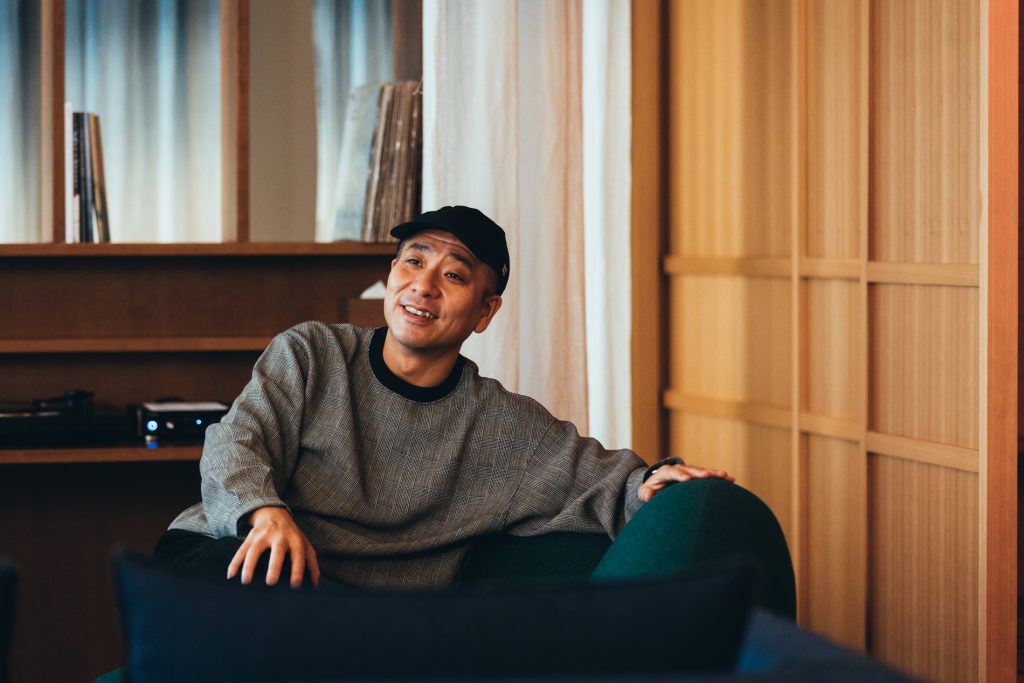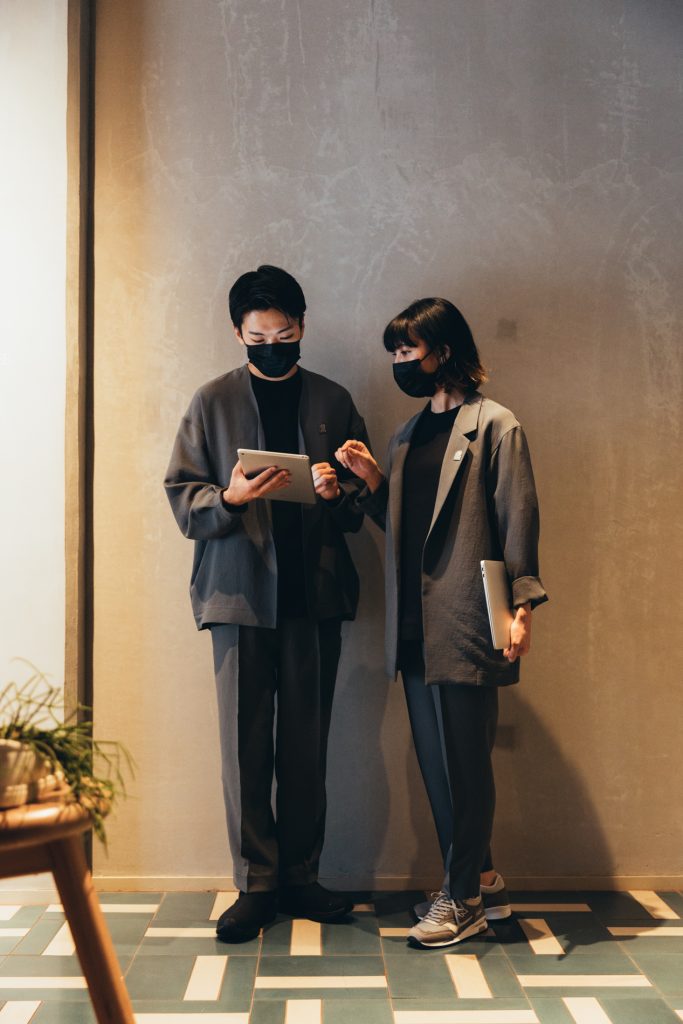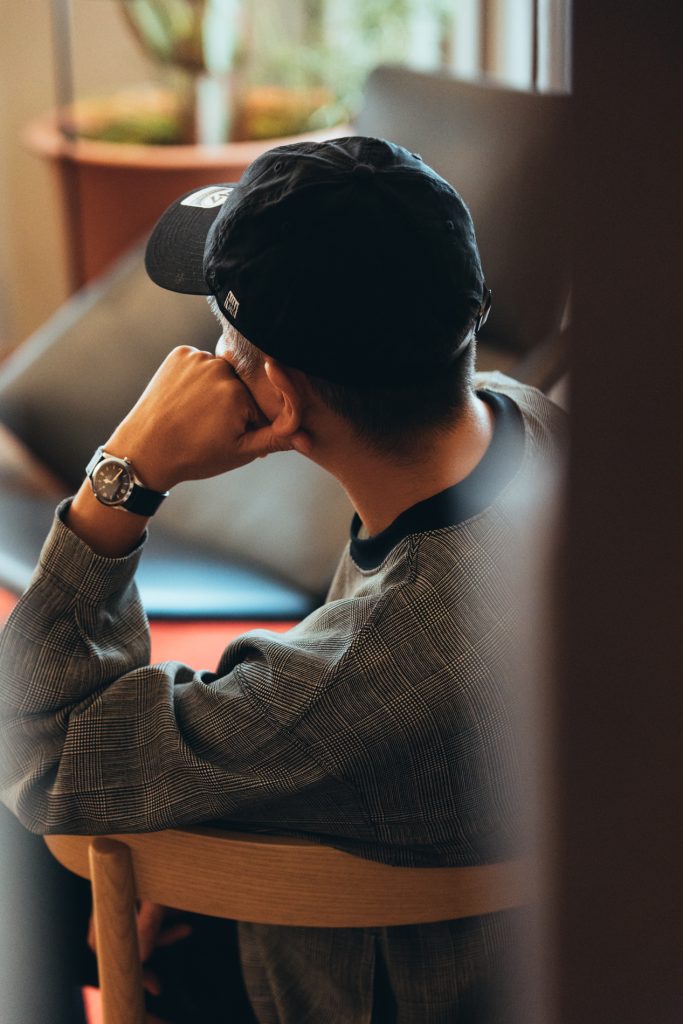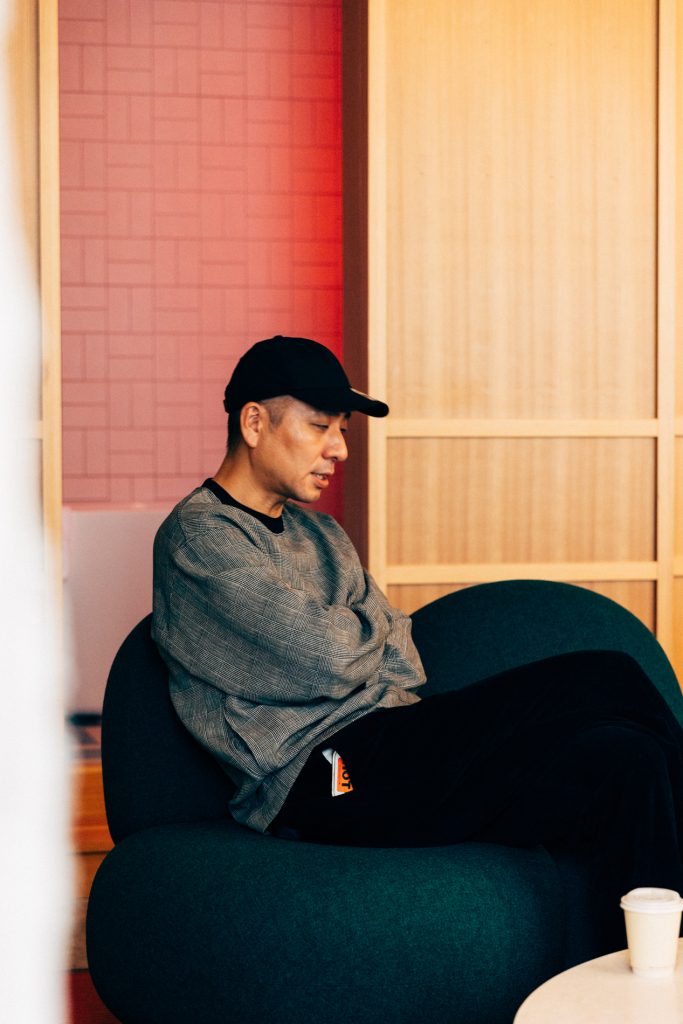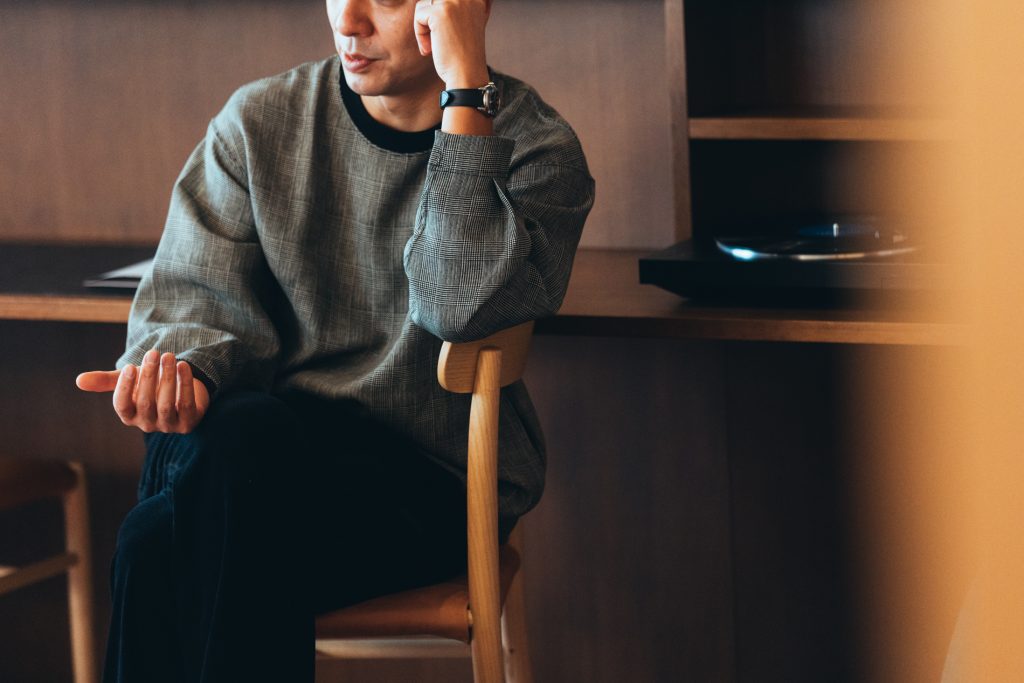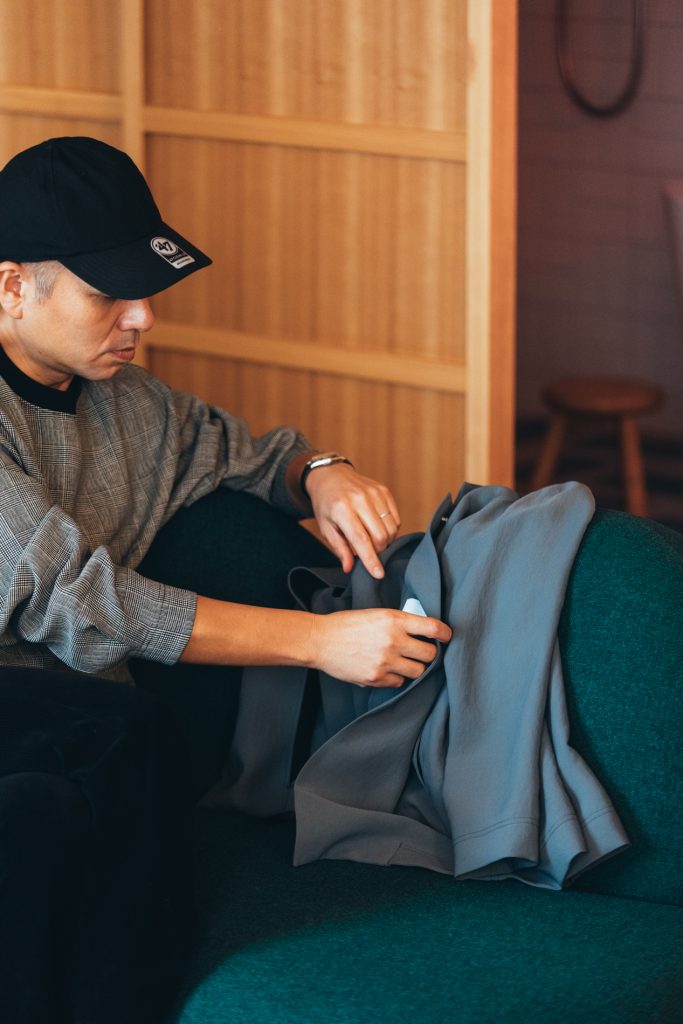


Inside Out.
Essence and functional beauty in the details
●You designed the current uniform for K5 Hotel, and I myself have recently traveled around the country in just one pair of these slacks and found them to be surprisingly comfortable to wear.
I used to travel a lot for work, so I’m not that fond of traveling per se, but with the pandemic going on, I find myself wanting to go. 20 years ago, when I still owned a vintage clothing store, I happened to see a friend of mine who lived in the US. He was returning home and only had with him his passport and wallet, nothing more. I thought it was really cool, this ultra-light style of traveling. No suitcase.
●What was he wearing?
He used to buy clothes and underwear locally and throw them away when they got dirty. When I saw how light he was traveling, it got me into the idea of ultralight clothes, and that interest developed over the years. It just so happens that during that time, thinking about mobility in clothes, I had to go to Alaska for work. I was so excited to go and brought my jacket, passport, and a bag from the convenience store. I thought I was going to die! It was so cold, that the keyhole of the car was frozen and so I couldn’t get in!
●Did your experience in Alaska have an influence on the way you make your clothes? Did the elements of old clothes and military become the base, or did functionality and mobility blend into it?
Alaska was a bit extreme, but after all, being as light as possible while still being able to adapt to different places is was what got me thinking about mobility. Also, I wasn’t really interested in whether or not to reflect this in my clothes, but rather my goal was to not carry so many things.
●What are some of the important elements that you consider when designing uniforms? For example, the medical check-up clothes for the clinic that you designed, or the design of the uniforms for the torch relay that you were a part of?
The only major difference from so-called ‘normal clothes’ is the regulations that come from the operation and the environment of the site, and that includes the time when the clothes are not being worn. In other words, uniforms require a lot more thought and difficulty on the part of the manufacturer than the wearer might think. The design must be linked to the operational aspects of the uniform, such as appearance, comfort, ease of folding when washing, and the ability to recognize the size of the uniform immediately.
●What did you think about the uniform design for the torch relay?
ASICS who produced the shoes are a sports manufacturer that is naturally competent and trustworthy in terms of function and materials. So I knew clearly that the part I had to concentrate on was the design, but that was also the most difficult part.
●What was the most challenging part of the project?
There were a lot of things that were expected of us, such as the artistic quality of the design, the connection between the design and the theme of the torch, and the shape of the uniform that had to fit many different body shapes. I guess there were many elements. But we had a great design team and a great product team, so it was really good that we were able to create something in about a year that would have otherwise taken three years.
●Is sturdiness an important element of uniforms?
Since they are worn every day, sturdiness is a prerequisite. People who incorporate mass-produced workwear into their fashion may be naturally attracted to the high level of robustness that comes from such functionality.
●Are there any examples of uniforms that have brought you joy?
I’m always happy when I hear someone say, “I want the uniforms they use there.” Also, as part of my job, I often stay at hotels, so I tend to check out their uniforms as well.
●Do you still look at hotels in that way?
I can’t help but be conscious of operations and checking amenities, and I even go out of my way to stay at certain hotels to see them in person. But, I think it all comes down to operations. I always pay attention to things like customer flow and hospitality, and that’s relevant to clothing stores as well.
●You think that service is highly important for clothing stores as well?
These days you can buy anything online, so a clothing store like ours will end up being limited to a single point that only sells clothes. That’s why I want to emphasize the importance of offline services. In that sense, as a clothing manufacturer, we need to look closely at these elements without being in the dark. It is because of this perspective that we can provide the functionality to the uniforms that workers wear. If this happens, uniforms will naturally become the center of our services.
●I’m often thinking about how we can utilize the beauty of this hotel building, which was built around 100 years ago, in our branding. In this sense, I think the new uniforms are a great match.
I think this is a rare case where the philosophy of the hotel matched well with the originally designed clothes. I would say that K5 picked up on what I have been doing for the past four years as UNITED ARROWS & SONS by DAISUKE OBANA. The philosophy of workwear that we discussed earlier seems to fit perfectly. That’s never really happened before, so I’m happy that the clothing will allow people to spend time more comfortably and that it matches the movement of the staff. This product is made from the same fabric that was developed by Komatsu Matere (*1) and has been updated over the years with the same structure, but actually, this fabric uses a raised backside for the front.
※1 Komatsu Matele Ltd.
A fabric manufacturer located in Nomi City, Ishikawa Prefecture. Formerly Komatsu Seiren.
I try to not listen to that kind of talk in the first place because I'd rather face the material with a clean slate and focus on the fabric from the point of view of what it can do and how it can reduce motion.
●When you see the fabric, does it make you think it would be interesting to turn it outside out?
People who make clothes usually visit fabric shops and come into contact with fabrics, so I think they often start by talking about the specifications given by fabric shops. It’s very easy to use terminology like that, but there is always a fixed idea attached to it. I try to not listen to that kind of talk in the first place because I’d rather face the material with a clean slate and focus on the fabric from the point of view of what it can do and how it can reduce motion. I’m a bit of an Amanojaku (a contrarian), so when someone says “the front” I tend to want to look at the back! Whether it’s cashmere or tweed, if I touch it and I’m interested in it, then I’ll ask the fabric maker for more details.
●Is the perspective of an Amanojaku an essential element in the creation of your clothes?
My work, as a buyer of used clothes, looking for clothes and selling them, has become the basis of my work. So my perspective of looking at clothes, as well as my own coordination, is basically the same as that of used clothes; turning them over, turning them inside out, looking at the lining, and looking at the tags. It may have been ingrained in me since my days at the thrift store. Before I knew it, I was spending more time as a designer making my own clothes.
●You went from being a vintage clothing buyer to a ready-to-wear designer.
To be honest, I didn’t know if it was right or not, but the products just moved on their own. I was desperate, and I’m still desperate in my head. I guess the result is that it’s right.
●How did it feel to see your ideas being recognized outside of Japan and around the world?
I didn’t think I had any special talent, and I never imagined I would be doing a collection in New York. When I was making my debut, I was so convinced that I had to be stoic and surreal as a designer that I suddenly started blasting Bach compilations! Now that I have a better understanding of who I am, I feel like I’m pursuing what I need at my own pace. I believe that the people who love me will understand me, no matter how they evaluate me.
●What has relieved you of such pressure?
What I was good at was comparing the back of old clothes and details to determine the year, such as turning over a pocket flap and finding out that the sewing and fabric were different, so I could say, “This is an early model from previous years”. There was a lot of information that wasn’t in magazines, so I was more interested in what I could see and touch at the thrift stores. It was normal to turn things over and take them apart, and it wasn’t a question of which side was the back or which side was the front, but rather, what was good, was good.
We live in an age where appearance is irrelevant. It's more about what you say and do, and your identity.
●The K5 staff are excited about the new uniforms, but do you think there is a special feeling in wearing them together, as a group?
Like uniforms and military uniforms, there may be a sense of belonging that works to unite us and make it easier for us to organize our feelings. On the contrary, it can be said that wearing the uniform makes it easier not to think about anything, but I think that uniforms have various elements, and on the other hand, there is a sense that they are disappearing rapidly.
●So what features do you think will remain for the future?
We live in an age where the focus is on a person’s identity rather than their appearance. We may come to an age where everyone wears the same clothes, even if they don’t want to, as long as they are made of comfortable materials and are easy to move in. In extreme cases, people will no longer be looking for color or shape, just like in the world of Osamu Tezuka or Seiko Hashimoto.
●Seiko Hashimoto, the speed skater and president of the Tokyo Olympic Organizing Committee?
Correct, taking her speed skating uniform as an example. Perhaps our generation is in trouble when I have to use Hashimoto as the only analogy! But seriously, what if we could create an amazing material that could cover your body tightly with just one piece, no matter how hot or cold it was? As long as you wear it, you don’t need to coordinate anything anymore.
●No more innovation in form?
I don’t think there will be any more innovation when it comes to form and comfort. At least not in the time I’m living in. For example, we live in an age where appearance is irrelevant. It’s more about what you say and do, and your identity. If the ultimate one-piece dress is created, there may be no need for anything else. Just as Steve Jobs did, if you combine the same colorless clothes every day, you will be able to coordinate (live) with less motion. If I had to say, I think there is still work to be done if we think in terms of clothes with less motion.
●Do you think that the reduction of motion means that you can spend more time on other things?
The fashion industry was able to grow because there were few hobbies and the maturity level was still low. The Ura-Harajuku area became a specification, and whether we knew it or not, the format of T-shirts, sweatshirts, jeans, and sneakers was formed there, and the fact that we still wear similar clothes implies that we don’t need anything else, even if we are not aware of it. The rest of the time can be spent doing what each of us likes, such as hobbies or experiencing various things.
I don’t closely follow how certain people wear my clothes. Rather, I feel that I’m creating clothes ’back to back’.
●My American friends are interested in the fact that Japanese people wear proper uniforms, unlike in the US where each person dresses down.
Since the United States is a country with many immigrants from various ethnic groups, there will inevitably be a hybrid style of dress that has passed through some sort of filter. From their point of view, it is understandable that they would be interested in the original culture of the island nation of Japan, such as the kimono.
●When you see a garment you designed worn in a way that betrays its original design or is worn in a completely unintended way, does that help inspire your designs?
A bit, but I don’t closely follow how certain people wear my clothes. Rather, I feel that I’m creating clothes ’back to back’. In other words, I revive my archived products by updating them for the modern age, or I design fabrics that other brands have and ask them to design fabrics that I have, swapping the original designs and fabrics. It’s not necessarily that we have to create from scratch, but we share ideas for fabrics that we think would be better. Even if a customer wears a piece inside out, it’s still part of the design.
●I’ve seen old men in Sugamo with unique styles, and I feel that the sense of originality, of not being caught up in trends, is more apparent in the elderly than in the young. Do you think the same can be said for the United States?
I don’t know if this answer is good for your question, but many designers of my generation grew up reading fashion magazines. However, I was always on the streets because I was a Shibukazi (*2), so I ended up being influenced by people on the streets. So when I went to the US for research, I saw people wearing socks over vinyl on the street, and I simply thought it was so beautiful and the layers were so cool. And I presented that inspiration at the show, I was slammed by fashion bloggers……..
※2 Shibukazi
The Shibuya casual fashion style popular in Shibuya in the late ’80s and early 90’s, with its roots in the rise of American casual, or “Amekaji”.
●It wasn’t that long ago that you were a fashion blogger, was it?
I didn’t mean to do that at all, I was just expressing what I thought was beautiful, but then the New York Times gave me a positive review, saying “Daisuke Obana, the designer, has beautifully incorporated the functional dressing of street people into his designs”. Since then, there have been many articles criticizing fashion bloggers removed from the web. Ten years in New York, and a lot has happened.
The warm and contemporary atmosphere of K5 meshes well with the surrounding stores to create a gap.
●What’s your impression of Kabutocho?
If it weren’t for this interview, I wouldn’t have known that the Tokyo Stock Exchange was located here. In New York, the tense atmosphere of Wall Street is still present, but here the warm and contemporary atmosphere of K5 meshes well with the surrounding stores to create a gap. It’s really interesting that there is a scene where local people enjoy and share time together in the middle of a big city, as opposed to the countryside. There is a strange feeling that wasn’t there before.
● “Strange feeling”, is that in a good way?
Naturally, I mean this in a good way. To begin with, a sense of discomfort is not a good or bad thing, but rather a feeling you get when you don’t know something. It is a sign that you are facing an aspect that people don’t yet understand.
●What was your impression of K5?
I really dislike boutique hotels (laughing). Most of them are filthy and lack hospitality with a shiny appearance. I stayed at a hotel once that was designed to be “photogenic” at a time when there was no Instagram. And the biggest rooms had one window and one bed… Back to K5, with its Swedish architectural team, I thought it was a good idea to harmonize the charm of the hotel with the exoticism. The colors and the appearance of the rooms make me realize how much I like them. If a Japanese architect had done it, it would have been too conscious of Japanese culture and it would have lacked unexpectedness. Now I’m looking forward to seeing how my impressions will unfold whilst I stay there!
●Finally, please tell us where you find the inspiration for your creativity.
I believe it is hidden in our daily lives. In the past, I think I used to find creativity in the special situations and emotions of the places I moved to, but that has changed over the years. I sometimes think I’ve become too fixated on the kind of experiences that fall in real places. I used to assume that if I didn’t go to the scene, I wouldn’t be able to find the real thing, but I began to think that this was just an ego that existed only in my mind and couldn’t be shared with others. Nowadays, we can see the world through the Internet, but even that information is an experience, isn’t it? Both are important, so as long as I don’t overlook the essence. I don’t get hung up on it, and I keep a cool head about it.
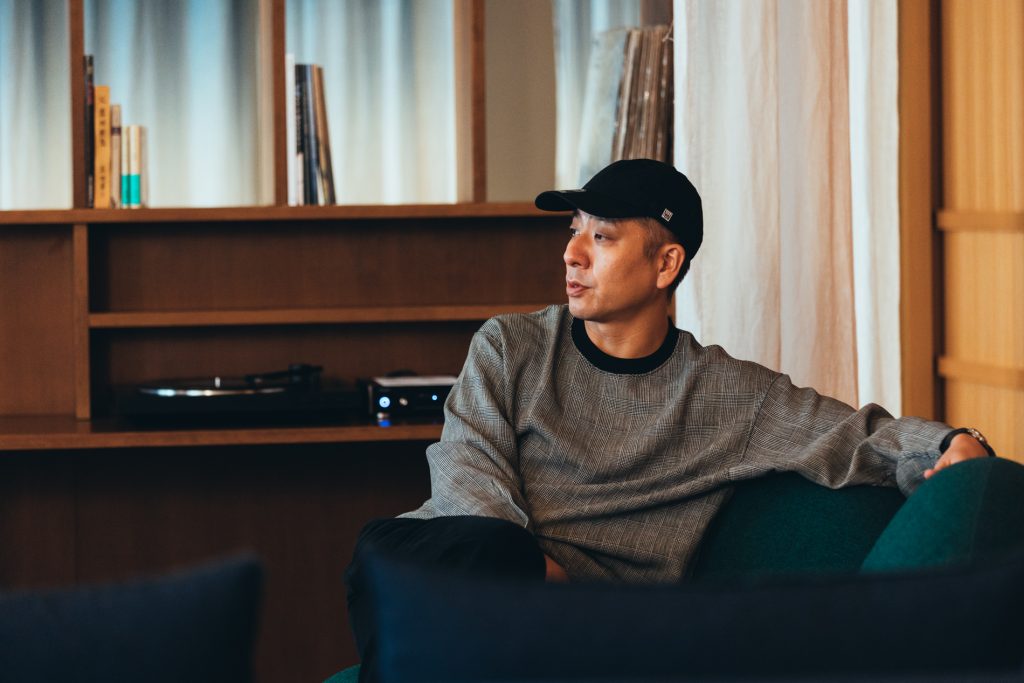
Daisuke Obana
Born in Kanagawa Prefecture in 1974. After gaining experience as a used clothing buyer and store manager of a well-known store in Harajuku, he was involved in the launch of the used clothing select store “go-getter”. After remaking used clothes and developing original products, he opened “Mister hollywood” in Harajuku in 2000. The name of the store came from a nickname he had given himself after spending many years in Hollywood on buying trips. The following year, in 2001, he established “N.HOOLYWOOD”. In 2017, he was appointed as the design director of men’s wear for MUJI LABO. His work on the Tokyo 2020 Olympic torch relay uniforms is still fresh in his mind.
Text : Jun Kuramoto
Photo : Naoto Date
Interview : Akihiro Matsui
